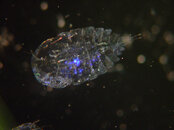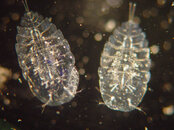See attached photos. These creatures are 2-3 mm. We found them in Roatan just off the wall between 10 and 100+ ft. Saw them last year Oct and Nov this year on several dawn dives. Behavior: Individuals in small scattered groups. They glow and pulse a bright blue (see photo with some pigment), when you get close (2-3 ft) they will flash/glow very brightly for about a second, the light goes off, the transulcent creature darts downward and away.
Entomologist @ home believes they are crustaceans.
Entomologist @ home believes they are crustaceans.






